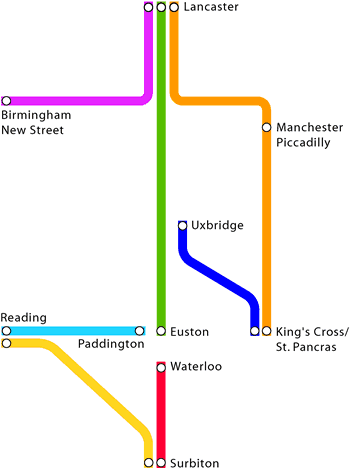
a map of the journeys you may make
all journeys begin at Lancaster... |
|
an ethnographer's guide to:
making a train journey
Laura Watts
'Travel time use in the information age' project
Centre for Mobilities Research
Lancaster University
A journey is both translation and transition, an experience of departure,
liminality and arrival*. A journey is therefore an effect, a performance,
of people, artefacts, buildings, weather and so on, which together
create
that experience (Law 2002). The weather, a laptop battery, an online
train timetable, a train guard: these coalesce (or not) into a multisensory
experience of travel. But travel takes effort: people, train
carriages, newspapers, track points must bind together, they must create
particular moments of coherence (arriving on a platform at the right
time to make a connection) and incoherence (a delay due to signalling
problems, may lead to a missed connection). And
actors such as
trains,
people
and books may resist combining together:
quiet carriages, for example, combine differently with mobile phones
than with paperback novels.
To journey, that is, for a traveller to experience departure, transition
and arrival, requires a mixing of themselves and others; travellers
must become cyborgs, part person, part train, part luggage and so on
(see Haraway 1991). Artefacts, moments in time,
particular places, all these may aid or resist the ongoing creation
of that journey and traveller. Each fluid mixing creates different
and changing experiences: time,
memory
and place are never fixed. To journey then is, perhaps simply, to make
and re-make a liminal time and place, and, ultimately,
to make arrival.
A journey is not a passive experience, it is not there to be consumed,
or merely passed through en route (for travelling without moving see
de Botton's discussion of Xavier de Maistre's room-travel, 2002: 244).
A journey is actively made through the traveller. It is made through
the transformation of the traveller and their experience of the world;
making the transition from departure to destination.
For example, a traveller extends themselves into the next seat
by
placing their luggage there, or they might make an experience of time
through seeing the movement of the sun and clouds outside the window,
or fold space
by
sleeping
between Edinburgh and Carlisle. A traveller is not just in motion,
but always in transition, mixed and entangled with many others: timetables,
tickets,
seats, coffee cups, overhead power cables, the timetable system.
They cannot experience the journey without becoming mixed up with them,
without
affecting and being affected.
These web pages are derived from experiences of travelling on trains
over a period of four months in Spring 2004: notes, photographs and
video-stills taken from over thirty journeys. This was not intended
to be a full piece of research, rather a tentative pilot to explore
the methodological issues involved in conducting research on-the-move.
The reader is also a traveller through these journeys, and so the pages
comprise
choices
for making
many journeys
through the material, and a short discussion at each destination. There
are three voices:
traveller:
quotes taken from my ethnographic material.
system:
taken from transport industry publications.
guide:
a voice for how these mixing
strategies of others and myself seem to perform, that is, a
guide for how to make the journey.
Overall,
it is a guide to the differing resistances offered by each
of the journey routes, routes derived not solely from a timetable but
also
from the
experience of the journey. Perhaps, ultimately, the diversities of
these experiences suggest that the notion of a singular experience
called 'a
train journey' may not even be meaningful.
begin your journey at Lancaster ...
* Although I am adopting the notion of liminality, I am not implying
journeys are rituals, in a formal, anthropological sense. Rather,
I would argue,
that the work of travelling
is necessarily a performance; see Adler, J. (1989). 'Travel as performed
art'. American Journal of Sociology 94: 1366-1391.
de Botton, A. (2002). The art of travel. London: Penguin
Haraway, D. (1991). Simians, cyborgs and women: the reinvention of
nature. London: Free Association Books.
Law, J. (2002). Aircraft stories: decentering the object in technoscience.
London: Duke University Press.
(c) All material in this document copyright the author. This document
may be cited or briefly quoted in line with the usual academic conventions. You
should observe the conventions of academic citation in the following
form: Laura Watts 'An ethnographic guide to: making a train journey'.
Published by the Centre for Mobilities Research, Lancaster University,
UK at http://www.lancs.ac.uk/postgrad/wattslj/cemore.
|

